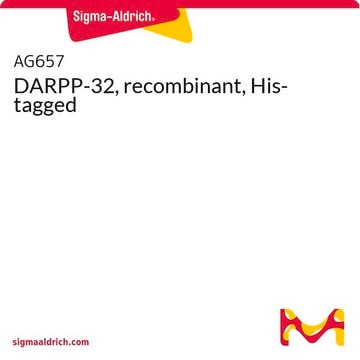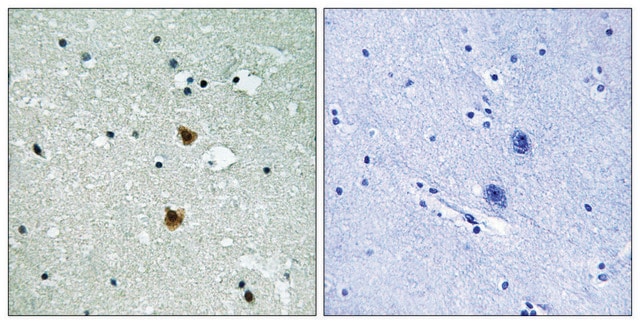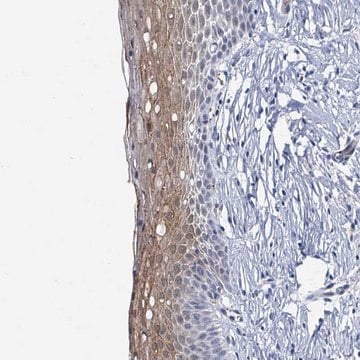推荐产品
生物源
rabbit
品質等級
抗體表格
affinity purified immunoglobulin
抗體產品種類
primary antibodies
無性繁殖
polyclonal
純化經由
affinity chromatography
物種活性
human
製造商/商標名
Chemicon®
技術
ELISA: suitable
immunohistochemistry: suitable
western blot: suitable
NCBI登錄號
UniProt登錄號
運輸包裝
dry ice
目標翻譯後修改
unmodified
基因資訊
human ... DRD3(1814)
特異性
Specific for Dopamine Receptor D3. Human Dopamine D3 receptor is a 400 aa, G-protein coupled and transmembrane receptor protein (Giros et al. 1990, 1991; Schmauss et al. 1993; Liu et al. 1994; Fu et al. 1995; Sokoloff et al. 1990; Livingstone et al. 1992). The immunogen peptide shows no significant sequence similarity with other dopamine receptors (D1, D2, D4 or D5).
免疫原
A 19 amino acid peptide sequence from the human D3 receptor within the 3rd cytoplasmic domain.
Epitope: cytoplasmic domain
應用
Detect Dopamine D3 Receptor using this Anti-Dopamine D3 Receptor Antibody, cytoplasmic domain validated for use in ELISA, IH & WB.
Research Category
Neuroscience
Neuroscience
Research Sub Category
Neurotransmitters & Receptors
Neurotransmitters & Receptors
Western blot: 1-10 μg/mL (Chemiluminescence technique) Approximately 100-400 μg of membrane protein/lane should be loaded to visualize the receptor band.
Immunohistochemistry: 1-20 μg/mL on paraformaldehyde fixed sections.
ELISA: 0.5-1.0 μg/mL (1 μg/mL immunogen peptide (Cat. Number AG224)/well)
Optimal working dilutions must be determined by the end user.
Immunohistochemistry: 1-20 μg/mL on paraformaldehyde fixed sections.
ELISA: 0.5-1.0 μg/mL (1 μg/mL immunogen peptide (Cat. Number AG224)/well)
Optimal working dilutions must be determined by the end user.
外觀
Affinity purified immunoglobulin. Liquid in PBS, pH 7.5 with 0.1% BSA. No preservatives
儲存和穩定性
Maintain at -20°C in undiluted aliquots for up to 12 months. Avoid repeated freeze/thaw cycles.
法律資訊
CHEMICON is a registered trademark of Merck KGaA, Darmstadt, Germany
免責聲明
Unless otherwise stated in our catalog or other company documentation accompanying the product(s), our products are intended for research use only and are not to be used for any other purpose, which includes but is not limited to, unauthorized commercial uses, in vitro diagnostic uses, ex vivo or in vivo therapeutic uses or any type of consumption or application to humans or animals.
Not finding the right product?
Try our 产品选型工具.
儲存類別代碼
10 - Combustible liquids
水污染物質分類(WGK)
WGK 2
閃點(°F)
Not applicable
閃點(°C)
Not applicable
Vijay Chandrasekar et al.
Molecular and cellular neurosciences, 42(4), 350-362 (2009-08-26)
MicroRNAs play key regulatory roles in cellular processes including neurogenesis, synapse development and plasticity in the brain. Psychostimulants induce strong neuroadaptive changes through a surfeit of gene regulatory mechanisms leading to addiction. MicroRNA profiling for identifying miRNAs regulating cocaine-induced, plasticity-related
Frederik Ravnkilde Marlet et al.
Biochimica et biophysica acta. Molecular basis of disease, 1870(6), 167212-167212 (2024-05-16)
Parkinson's Disease (PD) is characterised by the loss of dopaminergic neurons and the deposition of protein inclusions called Lewy Bodies (LBs). LBs are heterogeneous structures composed of protein and lipid molecules and their main constituent is the presynaptic protein α-synuclein.
Jian-Da Wang et al.
Autophagy, 11(11), 2057-2073 (2015-12-10)
Autophagy dysfunction is implicated in the pathogenesis of Parkinson disease (PD). BECN1/Beclin 1 acts as a critical regulator of autophagy and other cellular processes; yet, little is known about the function and regulation of BECN1 in PD. In this study
我们的科学家团队拥有各种研究领域经验,包括生命科学、材料科学、化学合成、色谱、分析及许多其他领域.
联系技术服务部门








